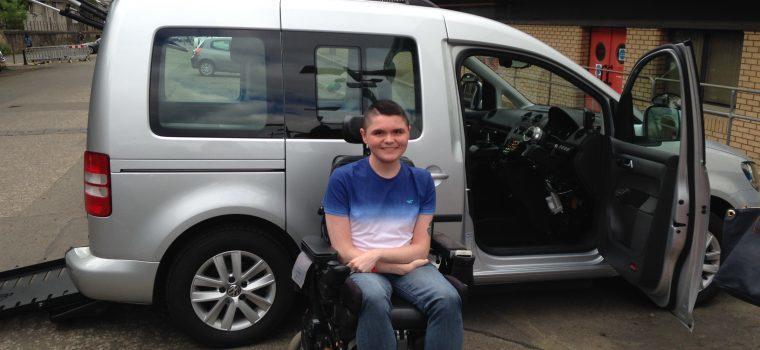Teenagers Driving with Muscular Dystrophy

A common rite of passage around the world for teenagers is learning to drive. For patients with muscular dystrophy, however, impaired muscle strength sometimes acts as a stumbling block to achieving this goal.
Parents worry that their child may never acquire the skills and learning to drive often gets pushed back to other immediate needs. These stories of three teens from three different countries, Canada, England and the US, show that it's possible.
Shaan Lail: Canada
At 19 years old, Shaan Lail became the first registered driver in Canada to use an electronic joystick system. The system is an example of adaptive equipment, which is technology designed to fit a person’s special needs. The type of equipment varies, but can enable a car to be driven by pulling levers or using a computer touchpad instead of using foot pedals. The joystick is a new particular type of adaptive equipment that operates like the smooth handle on gaming systems. It allowed Shaan the freedom to drive a car, a dream he had been waiting for since a young age.
In a story by CBC News, Shaan says, “I’d liked cars all my life, and it would be a shame if I [couldn’t] drive.” Another report included his mother’s perspective and how she was willing to do anything possible to make it happen. She has always encouraged her son, noting how she would remind him of what he could do with his life by writing “disability” and then crossing out the “dis” so that he would only see “ability.” She says, “I believe and I taught Shaan that you cannot control what life throws at you - just have to do the best you can.”
Shaan’s story took place in 2016, but already different parts of the world are adopting adaptive equipment, including the joystick system, and other tools to help muscular dystrophy patients gain the right to drive.
Connor Colhoun: England
In the UK, another 19-year-old with muscular dystrophy was recently granted the opportunity to drive. Connor Colhoun used his own car, a vehicle with adaptive equipment such as a mini steering wheel and levers instead of gas/brake pedals, to take lessons at the BSM (British School of Motoring) in order to earn his license.
Colhoun notes that while the school held him at equal standing with the other students, not granting him extra time to complete the test or requiring additional training, they were very accommodating to his needs, providing him with an instructor who came to his house for lessons and making sure the testing center where Colhoun took his exam was wheelchair accessible.
In an online interview with the muscular dystrophy organization in the UK, Colhoun says, “Driving is possible with muscular dystrophy, and I can enter and exit my car without needing any help... My advice is to try out driving if possible, as it’s life changing. I love it as it gives me so much independence and freedom.”
In the UK, drivers with muscular dystrophy called themselves the Trailblazers. More information and stories can be found on the website for Muscular Dystrophy UK.
Casey Stark: United States
Casey Stark always wanted to drive, but reasoning it wasn’t as critical as other issues and expenses in her life, she put it on hold until college. Once in school however, she accepted an internship out of town and could delay no longer. After visiting her local Division of Rehabilitation Driver Services office in Wisconsin, Stark was approved for funding and she began learning how to drive. The steps included being evaluated for what adaptive equipment would suit her best, practicing driving for 120 hours, and passing the driver’s test.
Once she attained her license, Stark bought a car, but she still had to wait several months for the adaptive equipment to be installed. In the end, her car included a ramp, a dashboard computer monitor, and a joystick control.
Stark has now been driving for over 5 years and offers her story as a testimony of hope to any fellow muscular dystrophy patient who may be dreaming of life behind the wheel. She says, “It has been a huge asset for my independence. I don’t have to rely on anyone or miss out on things. It helps me out professionally to be able to go to and from work by myself, and I can travel whenever I want to.”
Driving offers an optimistic future
A common thread in all of the stories mentioned was a shared dream for a greater future. Beyond driving, the teenagers desired independence so they could go to college and build careers. Eventually, their resilience and their parents’ desire for their success culminated in the fulfillment of these dreams.
Unfortunately the cost of adaptive equipment still remains a hefty sum (an estimated $70,000 in some cases) but there are grants available and government support which varies by state. The MDA suggests researching possible funding from health insurance companies, grants, rebates, government funding, and tax breaks. The community and non-profits also are good places to seek out financial aid. If all else fails, the MDA mentions that sometimes loans have provisions for special needs patients to reduce the cost.
All of these options may be sought in the United States; some of them may be available in other countries as well, but the results will vary, as they will also within the states.
Sources
https://www.aspirewny.org/blog/disabled-student-becomes-first-to-drive-using-new-joystick-system/
https://laforcedmd.com/driving-with-duchenne-muscular-dystrophy-dmd/
http://www.musculardystrophyuk.org/blog/a-drive-for-independence/
https://www.mda.org/quest/article/mobility-drivers-seat
















